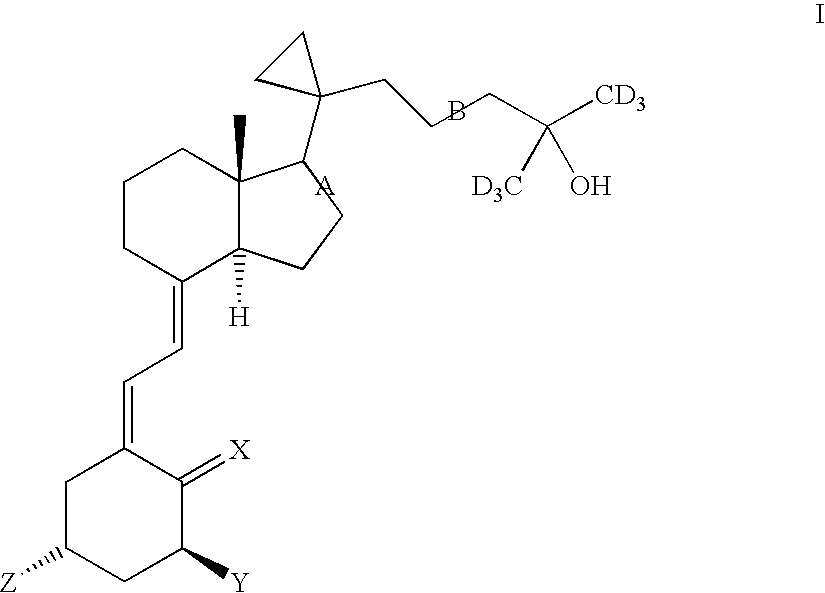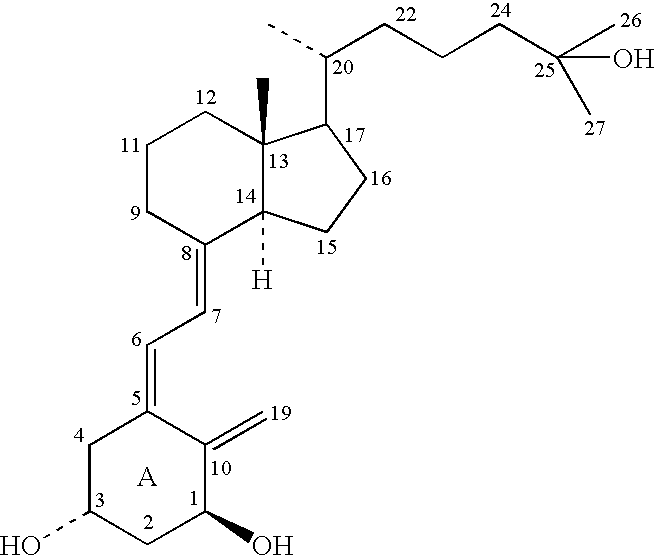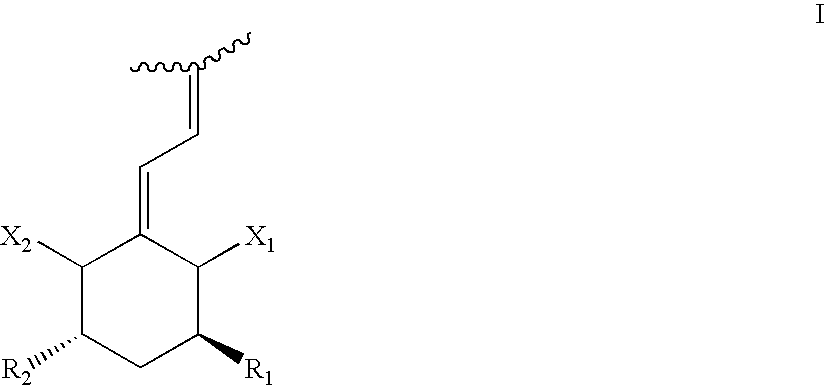1,25-dihydroxy, 20-cyclopropyl,26-27-deuteroalkyl vitamin d3 compounds and methods of use thereof
a technology of deuteroalkyl and vitamin d, which is applied in the field of 1, 25dihydroxy, 20cyclopropyl, 2627deuteroalkyl vitamin d3 compounds, can solve the problems of limited clinical application of vitamin d and its structural analogs, and achieve the effects of inhibiting transplant rejection, and preventing or treating bladder dysfunction
- Summary
- Abstract
- Description
- Claims
- Application Information
AI Technical Summary
Problems solved by technology
Method used
Image
Examples
example 1
Synthesis of 1,25-Dihydroxy-20-cyclopropyl-26,27-hexadeutero-19-nor-cholecalciferol (1)
(1R,3aR,4S,7aR)-2-{1-{4-(tert-butyl-dimethyl-silanyloxy)-7a-methyl-octahydro-inden-1-yl}-cyclopropyl}ethyl toluene-4-sulfonic acid ester
[0256]
[0257]A 100 ml round bottom flask equipped with stir bar and nitrogen sweep was charged with 5.98 g (16.958 mmol) of (1R,3aR,4S,7aR)-2-{1-{4-(tert-Butyl-dimethyl-silanyloxy)-7a-methyl-octahydro-inden-1-yl}-cyclopropyl}-ethanol, 50 ml of dichloromethane, 6 ml of triethylamine and 230 mg (1.883 mmol) of 4-dimethylamino pyridine. A 4.83 g (25.334 mmol) of tosyl chloride was added in one portion. The mixture was stirred at room temperature for 2 h.
[0258]The suspension was poured into a mixture of 40 g of ice, 100 ml of saturated sodium hydrogen carbonate solution and 100 ml of hexane. The aqueous layer was re-extracted three times with 50 ml of dichloromethane. These combined extracts were washed with 100 ml of brine, dried over Na2SO4 and evaporated.
[0259]The r...
example 2
Synthesis of Acetic acid 1α-acetoxy-25-hydroxy-20-cyclopropyl-26,27-hexadeutero-19-nor-cholecalciferyl ester (2)
[0292]
[0293]A 25 ml round bottom flask equipped with stir bar and Claisen adapter with rubber septum was charged with 245 mg (0.579 mmol) of 11,25-Dihydroxy-20-cyclopropyl-26,27-hexadeutero-19-nor-cholecalciferol and 6 ml of pyridine. The mixture was stirred at 0-5° C. and 1 ml (10.6 mmol) of acetic anhydride was added dropwise. The reaction mixture was stirred at 0-5° C. for 17 h and new portion 0.75 ml (7.9 mmol) of acetic anhydride was added dropwise. The reaction mixture was stirred for next 24 h.
[0294]The mixture was dissolved by the addition of 10 ml of water, stirred for 15 min and poured into 100 ml of ethyl acetate. The mixture was extracted five times with 50 ml of water and 50 ml of brine, dried over Na2SO4 and evaporated.
[0295]The oil residue was chromatographed on column (50 cm3, protected from light) using hexane:ethyl acetate (2:1) as mobile phase. Fractions...
example 3
1α,25-Dihydroxy-20-cyclopropyl-26,27-hexadeutero-cholecalciferol (3)
[0299]
[0300]A 50 ml round bottom flask equipped with stir bar and Claisen adapter with rubber septum was charged with 2.201 g (3.774 mmol) of (1S,5R)-1,5-bis-((tert-butyldimethyl)silanyloxy)-3-[2-(diphenylfosphinoyl)-eth-(Z)-ylidene]-2-methylene-cyclohexane and 15 ml of anhydrous tetrahydrofurane. The reaction mixture was cooled to −78° C. and 2.3 ml (3.68 mmol) 1.6M n-butyllithium in hexane was added dropwise. The resulting deep red solution was stirred at −78° C. for 20 min and 700 mg (1.888 mmol) of (1R,3aR,7aR)-7a-Methyl-1-{1-(5,5,5-trideutero-4-trideuteromethyl-4-trimethylsilanyloxy-pentyl)-cyclopropyl}-octahydro-inden-4-one was added dropwise in 2 ml of anhydrous tetrahydrofurane. The reaction mixture was stirred for 4 h and then the bath was removed and the mixture was poured into 60 ml of ethyl acetate and 50 ml of brine. The water fraction was extracted four times with 75 ml of ethyl acetate, dried over Na2...
PUM
| Property | Measurement | Unit |
|---|---|---|
| flow rate | aaaaa | aaaaa |
| volume | aaaaa | aaaaa |
| volume | aaaaa | aaaaa |
Abstract
Description
Claims
Application Information
 Login to View More
Login to View More - R&D
- Intellectual Property
- Life Sciences
- Materials
- Tech Scout
- Unparalleled Data Quality
- Higher Quality Content
- 60% Fewer Hallucinations
Browse by: Latest US Patents, China's latest patents, Technical Efficacy Thesaurus, Application Domain, Technology Topic, Popular Technical Reports.
© 2025 PatSnap. All rights reserved.Legal|Privacy policy|Modern Slavery Act Transparency Statement|Sitemap|About US| Contact US: help@patsnap.com



